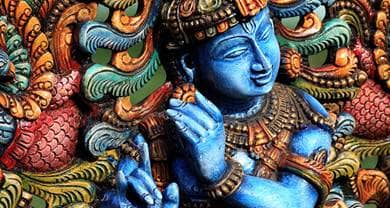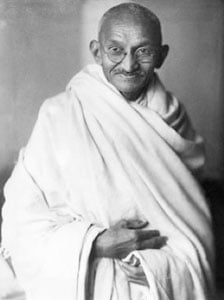- Trending:
- Pope Leo Xiv
- |
- Israel
- |
- Trump
- |
- Social Justice
- |
- Peace
- |
- Love

RELIGION LIBRARY
Hinduism
Principles of Moral Thought and Action
The term "Hinduism" encompasses an incredibly diverse array of beliefs and practices, to the point that Hindus in one part of India might hold particular beliefs and engage in particular practices that would be virtually unrecognizable in another part of India. That said, there are two underlying principles in the Hindu world that are and have been shared by virtually all Hindus: dharma and karma. These principles fundamentally inform Hindu conceptions of moral thought and action.
Dharma is one of the most complex and all-encompassing terms in all of Hinduism: it can mean religion, law, duty, order, proper conduct, morality, righteousness, justice, norm. As such, dharma fundamentally underlies conceptions of morality and ethics in Hinduism. Dharma puts things in their proper place, creates and maintains order and balance. In the vast compendium of literature known as the Dharmashastras, dharma is examined from virtually every imaginable angle, from the proper performance of sacrifice, kingly duties, cultural norms, sexual relations, and everyday social rules such as manners.
| CASTES | |
| Brahmin | (priestly caste) |
| Kshatriya | (traditionally warrior caste) |
| Vaishya | (traditionally caste of merchants and farmers) |
| Shudra | (manual laborers) |
To act dharmically is, in essence, to act appropriately; what is appropriate is determined by the context in which the action is to be performed and who is performing it. Different people have different dharmas; one's caste, one's position in life (ashrama), one's gender, all determine what is dharmic in a particular instance. The ethical and moral guidelines for a Kshatriya are different than those for a Brahmin, which are in turn different from those for a Shudra. This is sometimes called "svadharma," or one's own, personal dharma. The specifics of these guidelines are discussed in great detail in the Dharmashastras and their commentaries.
| THE FOUR ASHRAMAS | |
| Ashrama (station in life) | Duties |
| Student | Learn duties of his caste |
| Householder | Raise a family |
| Forest dweller | Study sacred texts |
| Renouncer | Meditate |
Thus in Hinduism specific ethical and moral guidelines vary; the general ethical and moral principle does not, however. That amounts to a simple moral and ethical imperative: act properly (dharmically).
Karma is intimately associated with dharma in this regard. Karma is understood in Hinduism as a universal law of cause and effect. Positive actions produce positive effects; negative actions produce negative effects. To act dharmically is to act in a karmically positive manner, therefore. When one acts dharmically, one necessarily produces positive karma. This karma is cumulative: one accrues karma, positive and negative, not only throughout the course of one's life, but throughout the course of one's multiple rebirths. It is karma that determines one's rebirths.
There is a tension that surfaces at times in these discussions, a tension between one's ethical and moral duty to the well-being of society and others, and one's personal religious progress toward salvation, moksha. Karma, negative and positive, keeps us in the world, leading to birth after birth after birth (this is samsara). To attain ultimate salvation, moksha, is to attain release from this cycle. One accomplishes this by eliminating all karma, negative or positive.
 An extremely important ethical element that pertains to both karma and dharma is the principle of ahimsa, non-violence. This is a very old idea in Hinduism, emerging in its ethical sense in texts as ancient as the Mahabharata,where non-violence is said to generate positive karma. The idea behind ahimsa is that all beings are karmically interconnected; any action that harms another being, whether it be a Brahmin priest or a worm, is thus said to affect every other being. To kill an animal, then, is to karmically affect not only oneself (and the dead animal, of course), but collectively all other beings.
An extremely important ethical element that pertains to both karma and dharma is the principle of ahimsa, non-violence. This is a very old idea in Hinduism, emerging in its ethical sense in texts as ancient as the Mahabharata,where non-violence is said to generate positive karma. The idea behind ahimsa is that all beings are karmically interconnected; any action that harms another being, whether it be a Brahmin priest or a worm, is thus said to affect every other being. To kill an animal, then, is to karmically affect not only oneself (and the dead animal, of course), but collectively all other beings.
The principle of ahimsa can be taken to extremes, leading to a severe sort of asceticism that is essentially absolute non-action, since almost any action can, in some way, lead to harm—one might accidently step on an ant, say, or accidently breathe in a tiny fly. There are thus long and sometimes very complex philosophical discussions of ahimsa, including discussions of the importance of intentionality or volition in harming another being. Many schools hold that one only generates karma when one acts willfully, when one is aware of one's actions and consciously chooses them.  Jainism split, in part, over this matter, and adopted a radical mode of being that held that any harm to any being, including certain plants, intentional or not, was ethically wrong. (Not all Jains hold to this radical view, however.)
Jainism split, in part, over this matter, and adopted a radical mode of being that held that any harm to any being, including certain plants, intentional or not, was ethically wrong. (Not all Jains hold to this radical view, however.)
Mahatma Gandhi was an advocate of ahimsa, applying it to all aspects of his life, most famously in the political realm. Ahimsa was his fundamental moral and ethical principle, and his teachings on the matter continue to be extremely popular in Hinduism (and outside of the Hindu world as well), regarded as an ideal—if not always an actual—ethical and moral guiding principle.
Study Questions:
1. What are the minimal conditions for being a Hindu?
2. How is dharma static? How does it change with contextualization?
3. Describe the relationship between dharma and karma.
4. What is ahimsa? Why is it widely practiced?










